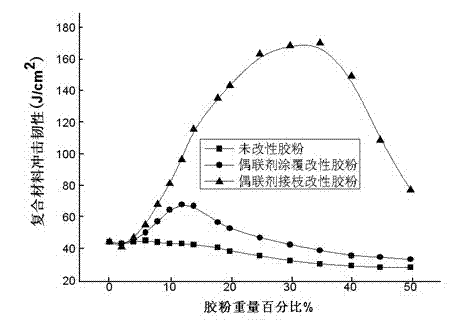Chemical modification method of polymer powder
A technology of polymers and polymer particles, applied in the field of chemical modification of polymer powders
- Summary
- Abstract
- Description
- Claims
- Application Information
AI Technical Summary
Problems solved by technology
Method used
Image
Examples
Embodiment 1
[0046] Stir and disperse 100g polymethylmethacrylate (PMMA) powder with an average particle size of 25μm to 300ml containing 5% diethylenetriamine (weight ratio, the same below), 15% KH-550 and 20% dilute hydrochloric acid (original concentration 15%) in diethylene glycol monomethyl ether solution. The ultrasonic treatment was performed with 300W power for 10min, and then placed in a 900W power microwave generator to stir, put in the cooling water inner coil, and the microwave generator was operated at half-full power. The temperature of the reaction system was controlled not to exceed 110°C for a total reaction of 20min. The polymer powder was obtained by filtration, washed with ethanol 3 times (200ml ethanol each time), and dried in vacuum. XPS measured the ratio of C / Si atoms on the surface of polymer particles to be 100:14.3. Measured with MasterSizer 2000 laser particle size analyzer (Malvern, UK), the average particle size is almost unchanged, still about 25μm.
Embodiment 2
[0050] Stir and disperse 100g polymethylmethacrylate (PMMA) powder with an average particle size of 5μm to 300ml containing 5% diethylenetriamine (weight ratio, the same below), 20% diethylenetriaminopropyltrimethoxysilane (Wolker A-1130) and 30% dilute hydrochloric acid (original concentration 15%) in diethylene glycol monomethyl ether solution. Firstly treat with 300W power ultrasonic for 10min, then put it in a 900W power microwave generator and stir, put in the cooling water inner coil, the microwave generator works at 50% full power, control the temperature of the reaction system not to exceed 110℃, and react for 30min in total . The polymer powder was obtained by filtration, washed with ethanol 3 times (200ml ethanol each time), and dried in vacuum. XPS measured the ratio of C / Si atoms on the surface of polymer particles to be 100:16.2. Measured with MasterSizer 2000 laser particle size analyzer (Malvern, UK), the average particle size is almost unchanged, still about 5...
Embodiment 3
[0052] Disperse 100g of polymethylmethacrylate (PMMA) powder with an average particle size of 780μm to 300ml containing 5% diethylenetriamine (weight ratio, the same below), 10% N,N-bis-(triethoxy) Silicon propyl) imine (G-402) and 10% dilute hydrochloric acid (original concentration 15%) in diethylene glycol monoethyl ether solution. Firstly treat with 300W power ultrasonic for 10min, then place it in a 900W power microwave generator and stir, put in the cooling water inner coil, the microwave generator works at 80% full power, control the temperature of the reaction system not to exceed 110℃, and react for 8min in total . The polymer powder was obtained by filtration, washed with ethanol 3 times (200ml ethanol each time), and dried in vacuum. XPS measured the ratio of C / Si atoms on the surface of polymer particles to be 100:21.5. Measured with the MasterSizer 2000 laser particle size analyzer (Malvern, UK), the average particle size is almost unchanged, still about 780μm.
PUM
| Property | Measurement | Unit |
|---|---|---|
| particle size | aaaaa | aaaaa |
| particle size | aaaaa | aaaaa |
| density | aaaaa | aaaaa |
Abstract
Description
Claims
Application Information
 Login to View More
Login to View More - R&D
- Intellectual Property
- Life Sciences
- Materials
- Tech Scout
- Unparalleled Data Quality
- Higher Quality Content
- 60% Fewer Hallucinations
Browse by: Latest US Patents, China's latest patents, Technical Efficacy Thesaurus, Application Domain, Technology Topic, Popular Technical Reports.
© 2025 PatSnap. All rights reserved.Legal|Privacy policy|Modern Slavery Act Transparency Statement|Sitemap|About US| Contact US: help@patsnap.com


